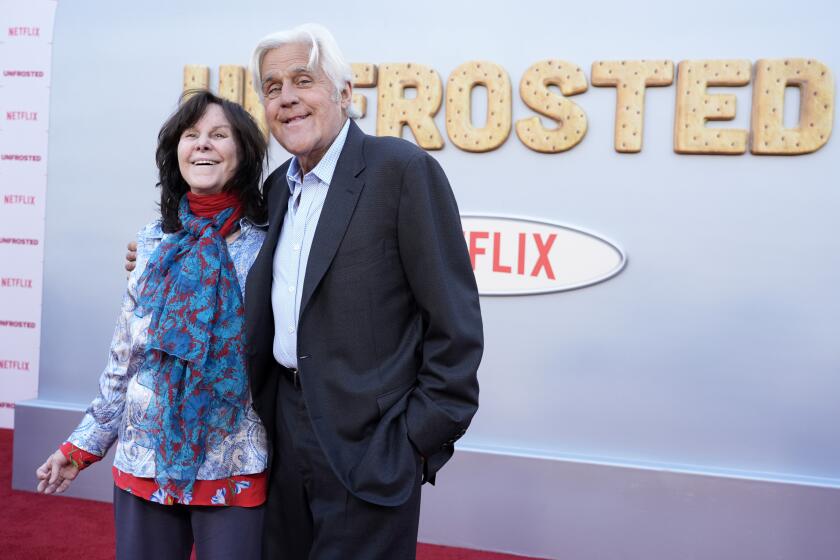ART REVIEW : The Later Years : Work From the ‘80s Provides the Missing Coda for Willem de Kooning, One of the Century’s Greats
- Share via
SAN FRANCISCO — Among the least convincing controversies of the rambunctious 1980s was the one about the aged American master of abstract expressionist painting Willem de Kooning. Was his newly revived career a miracle or a hoax?
Born in Holland in 1904 and a hero in New York by 1950, De Kooning had famously gone to seed by the end of the 1970s. The originator of a boisterous idea of painting-as-adventure, he had gotten lost in a haze of often violent alcoholism and was almost never able to paint. A telltale gap in the careful chronology in last year’s great De Kooning retrospective at the National Gallery of Art saw the period between 1978 and 1981 represented by a single work.
In the 1980s, however, as a newly sober De Kooning suddenly became productive once again, he also began to slide into the steadily debilitating effects of what doctors believe is Alzheimer’s disease. Could paintings produced by an artist with a seriously faltering memory really be any good?
Was this seeming renewal an authentic “late style” in a great artist’s career? Or was it just more proof of the venality and corruption of an exploding art market, in which De Kooning (and his heirs) would make a lucrative killing while burnishing the aura of younger painters through the revival of an ancestral hero, in an art world newly enamored of painting? And how much of this work was actually by De Kooning anyway, and how much was the labor of “helpful” studio assistants?
Peter Schjeldahl, long a fervent admirer of De Kooning’s art and among the most eloquent critics of his paintings, responded with typical brio to overwrought claims of diminished artistic capacity. The question is beside the point, he calmly said, because De Kooning had in fact never painted with his brain; he painted with his wrist .
For his part, Schjeldahl had done something that too few commentators actually do: He looked at De Kooning’s paintings for the answer, and he looked hard.
That is also what Gary Garrels and Robert Storr have recently done. Garrels is curator at the San Francisco Museum of Modern Art, where his exhibition, “Willem de Kooning: The Late Paintings, The 1980s,” opened last week. Storr is curator at New York’s Museum of Modern of Art, where the show will eventually conclude a 19-month international tour.
They are also contributors of insightful essays to a useful catalogue, whose one flaw is truly wretched color reproductions. In 35 well-chosen paintings that provide a tight, year-by-year chronology laid out in eight galleries, the exhibition dispels any lingering controversy with--well, with a flick of the artist’s incomparable wrist.
The show begins in 1981, when De Kooning was 77, with five paintings that pick up where he had left off three years earlier. The size of the canvases remains the same--approximately six or seven feet to a side--but the thick, fluid, tightly organized, gestural slathers of paint begin to open up. The paint thins, and signs of a scraper dragged over the surface appear, resulting in the emergence of multiple smeary layers on the canvas surface.
The pictures start to feel more buoyant, airier, more luminous, while some of their layered physical history oozes out. It is a direction that, with certain variations, the artist would follow through the decade.
The show is installed in the third-floor galleries of the museum’s handsome new building, whose filtered natural light is ideal for paintings in which interior light is often a major theme. De Kooning was working, as he had for several decades, near the Atlantic Ocean on Long Island, and it’s easy to see intimations of seaside landscape in these expansive pictures.
To oversimplify a body of work whose own simplicity was reached only through decades of intense labor: The paintings from 1981 seem to be mostly about color; from 1982, mostly about structure; from 1983, about their delirious merger. My favorite year is 1984, when De Kooning just seems to be enthralled with what he’s been able to put back together in painting, and he’s trying out his entire repertoire.
There are impossible moves, such as the fusion between fleshy pink and radiant blue in 1982’s “Untitled XXIII.” Thin, whiplash lines of blue-black paint carve out bulging forms that somehow dissolve into air in 1983s “Untitled II.” You know De Kooning’s really back when even the oily surface sheen is composed in consideration of the nearby play of matte colors in several paintings from 1984.
A capital-M Modernist, De Kooning paints in a way that is happily old-fashioned. And there are pictures in this show that are as flat-out satisfying as any abstract paintings you could name.
Like Mondrian (another Dutchman), De Kooning emphasizes the primaries--red, yellow, blue--plus white, while accomplished guest appearances are also made by orange, green and violet. Many pictures recall his great abstractions of the 1940s, scenery-chewing masterpieces such as “Attic” and “Excavation,” although their fierce, aggressive moves have been remade as lyrical flights of imagination.
A full landscape of lived experience is internalized in these late works, inescapably the paintings of an old man. A radiant principal of perpetual change and redemptive opportunity unfolds.
De Kooning didn’t stop painting until 1990, but the show ends in 1987. The curator’s decision seems correct. Starting in 1985, the paintings begin to wobble a bit. De Kooning is trying out--once again--yet more directions, but the pictures sometimes lose focus. The least successful feel static. Infirmity is catching up with him.
Last year’s otherwise magnificent National Gallery retrospective was marred by a generally weak selection of late De Koonings, which didn’t quell confusion about his paintings of the 1980s. This show will. It elaborates the missing coda to an extraordinary career, demonstrating once more why Willem de Kooning is one of the century’s greatest painters.
* San Francisco Museum of Modern Art, 151 Third St., (415) 357-4000, through Jan. 7. Closed Mondays.
More to Read
The biggest entertainment stories
Get our big stories about Hollywood, film, television, music, arts, culture and more right in your inbox as soon as they publish.
You may occasionally receive promotional content from the Los Angeles Times.











